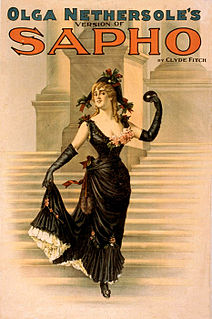
Matthew Raymond Dillon is an American actor and film director. He made his feature film debut in Over the Edge (1979) and established himself as a teen idol by starring in the films My Bodyguard (1980), Little Darlings (1980), Tex (1982), Rumble Fish (1983), The Outsiders (1983) and The Flamingo Kid (1984). From the late 1980s onward, Dillon achieved further success, starring in Drugstore Cowboy (1989), Singles (1992), The Saint of Fort Washington (1993), To Die For (1995), Beautiful Girls (1996), In & Out (1997), There's Something About Mary (1998), and Wild Things (1998). In a 1991 article, famed movie critic Roger Ebert referred to him as the best actor within his age group, along with Sean Penn.
SAPHO syndrome includes a variety of inflammatory bone disorders that may be associated with skin changes. These diseases share some clinical, radiologic, and pathologic characteristics.

Sapho (1950) is a French singer. Her real name is Danielle Ebguy.

Sapho is a pièce lyrique in five acts. The music was composed by Jules Massenet to a French libretto by Henri Cain and Arthur Bernède, based on the novel of the same name by Alphonse Daudet. It was first performed on 27 November 1897 by the Opéra Comique at the Théâtre Lyrique on the Place du Châtelet in Paris with Emma Calvé as Fanny Legrand. A charming and effective piece, the success of which is highly dependent on the charisma of its lead soprano, it has never earned a place in the standard operatic repertory.
Osteitis is inflammation of bone. More specifically, it can refer to one of the following conditions:

Sapho and Phao is an Elizabethan era stage play, a comedy written by John Lyly. One of Lyly's earliest dramas, it was likely the first that the playwright devoted to the allegorical idealisation of Queen Elizabeth I that became the predominating feature of Lyly's dramatic canon.

Sapho is a 3-act opera by Charles Gounod to a libretto by Émile Augier which was premiered by the Paris Opera at the Salle Le Peletier on 16 April 1851. It was presented only 9 times in its initial production, but was a succès d'estime for the young composer, with the critics praising Act 3 in particular. It was later revived in 2-act (1858) and 4-act (1884) versions, achieving a total of 48 performances.

The Eternal Sapho is a 1916 American silent drama film directed by Bertram Bracken and starring Theda Bara. The film was based on the 1881 French novel Sapho, by Alphonse Daudet. The film is now considered lost.

Sapho was a 1900 American play by Clyde Fitch, based on an 1884 French novel of the same name by Alphonse Daudet and an 1885 play by Daudet and Adolphe Belot. It was at the center of a sensational New York City indecency trial involving the play's star and producer/director, Olga Nethersole. The play was not an exceptional success but the incident is considered a notable step in the transformation of American society's attitudes regarding gender roles and public depictions of sex in the 20th century.
Apomecynini is a tribe of longhorn beetles of the Lamiinae subfamily.

Sybra is a genus of beetles in the family Cerambycidae, containing the following species:
Sapho is a 1917 American silent drama film directed by Hugh Ford and written by Hugh Ford and Doty Hobart. The film stars Pauline Frederick, Frank Losee, John St. Polis, Pedro de Cordoba, and Thomas Meighan. It is based on the novel Sapho by Alphonse Daudet. The film was released on March 11, 1917, by Paramount Pictures. It is not known whether the film currently survives.
Sybra eumilis is a species of beetle in the family Cerambycidae. It was described by Dillon and Dillon in 1952.
Sybra catopa is a species of beetle in the family Cerambycidae. It was described by Dillon and Dillon in 1952.
Sybra dimidiata is a species of beetle in the family Cerambycidae. It was described by Dillon and Dillon in 1952.
Sybra eson is a species of beetle in the family Cerambycidae. It was described by Dillon and Dillon in 1952.
Sybra puella is a species of beetle in the family Cerambycidae. It was described by Dillon and Dillon in 1952.
Sybra syces is a species of beetle in the family Cerambycidae. It was described by Dillon and Dillon in 1952.
Sybra fulvoapicalis is a species of beetle in the family Cerambycidae. It was described by Dillon and Dillon in 1952.








